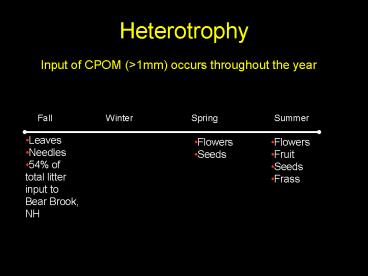Heterotrophy - PowerPoint PPT Presentation
1 / 24
Title:
Heterotrophy
Description:
From: Webster et al. (1999) Effect of discharge on organic matter ... crayfish. freshwater shrimp. snails. Tipulidae (crane fly larvae) trichopterans ... – PowerPoint PPT presentation
Number of Views:58
Avg rating:3.0/5.0
Title: Heterotrophy
1
Heterotrophy
Input of CPOM (gt1mm) occurs throughout the year
Fall Winter
Spring Summer
- Leaves
- Needles
- 54 of total litter input to Bear Brook, NH
- Flowers
- Seeds
- Flowers
- Fruit
- Seeds
- Frass
2
Litterfall composition, Glenwild Lake, NJ
Sebetich Horner-Newfeld (2000)
3
Fate of allochthonous material once it enters a
stream
- Breakdown - Function of
- Physical
- Chemical
- Biological actions
- Transport Function of
- Discharge
- Streambed composition
4
From Webster et al. (1999)
5
Effect of discharge on organic matter
concentration in streams
6
- CPOM trapped more efficiently by
- Channel roughness
- Backwaters
- Debris dams
- Trapping efficiency can be determined
experimentally - Leaves small wood may travel lt10 meters
downstream - (about 100m during spate)
- FPOM travels about 200m downstream
7
- Fate of CPOM
- Leaching
- Microbe colonization
- Fragmentation
(Allan 1995)
8
Microbes
- Decompose leaves and other o.m.
- Make leaves more palatable nutritious to
shredders - e.g., Cummins cracker peanut butter example
Fragmentation
- By invertebrates
- About 25 of leaf degradation is due to
- invertebrate animals
9
FPOM (0.45-1000 µm)
- examples fragments, fine terrestrial particles,
algae, feces of invertebrates - More easily transported due to the small size
- Availability to consumers influenced by discharge
and instream obstructions - FPOM travel in stream 200m
- FPOM feeders ingest gt4x their weight/day
- Total standing crop of FPOM in Sycamore Creek, AR
injested and egested every 2-3 days
10
DOM
- Sources
- Soil o.m. shallow groundwater (2-30 mg/L)
- Precipitation (1 mg/L)
- Below canopy (2-3 mg/L)
- Canopy drip (25 mg/L)
- Extracellular releases from algae
- Leaf leachate of DOC
- Fate
- Taken up rapidly (within 48-72 hrs)
- Adsorption onto clays
- Complexation reactions w/Al Fe
- Flocculation
- Photochemical destruction
11
Annual Energy Budget for Bear Brook, NH
12
(No Transcript)
13
Food (energy) Processing
- Major Food Resource Pools in Lotic Systems
- Detritus CPOM FPOM
- Periphyton
- Macrophytes
- Prey
- What processes these and how?
- Shredders
- Collectors
- Scrapers Grazers
- Piercers
- Predators
14
Role of Microbes
Fully conditioned
Conditioning
Time
3-4 weeks
15
The influence of conditioning time of discs of
hickory leaves on utilization by Tipula
abdominalis. (From Allan, 1995)
16
What is the Fate of Microbial Biomass?
- microbes metazoans macroinverts
fish - - major energy losses with each trophic level
- microbes
-
mineralization
Microbe Loop
link vs. sink debate
17
What Consumes CPOM?
- amphipods (Gammarus)
- isopods
- crayfish
- freshwater shrimp
- snails
- Tipulidae (crane fly larvae)
- trichopterans
(wood consumers midges, elmids, caddisfly,
cranefly)
18
(No Transcript)
19
FPOM Processors
- Captured from
- Suspension collectors-gatherers
- Substrate grazers scrapers
- Suspension Feeding Capture Mechanisms
- Setae on mouthparts or forelegs
Source Hynes (1972)
20
- Use of structures on the head
Source Hynes (1972)
21
- Catch Nets (esp. Trichoptera, some Chironomids)
Source Hynes (1972)
22
- Production of current through tubes
23
FPOM Processors (continued)
- Deposit Feeding (grazers/scrapers)
- Feeding while burrowing
- - e.g., annelids
- Feeding on surface deposited particles
- - snails, stonefly (Brachyptera)
24
Is temporal and spatial variability in substrate
food sources
- Some species are capable of
- - differential ingestion usually select
- higher of small particles
- - differential digestion
- e.g., high quality foods rapid absorption
- high feeding rates short GRT
- e.g., low quality foods slow
absorption - low feeding rates long GRT































